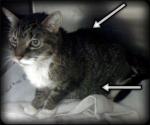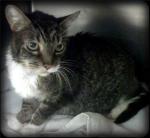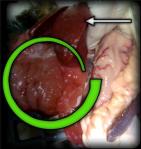18-Year-Old Cat Getting Fat for No Reason
“My old cat is gaining weight!”
A friendly tabby striped cat with white paws peered out through the cat carrier door.
“Doc, my wife’s mother came to visit two months ago and she said Sparky gained weight. We weren’t sure, but it did look like her belly was bigger. So we switched her to Senior weight loss food. But it looks like she’s still gaining weight.”
Actually, Sparky lost muscle over her shoulders, back, and hips while her belly sagged and grew large and pendulous. Over-all, if you picked her up, she would feel heavier. But the weight was in all the wrong places!
Why would an 18-year old cat suddenly start gaining weight?
Probably no “good” reason!
Doc Truli says,”It’s common for people to miss weight loss or gain in their pet. Then a friend or relative visits and sees the difference right away. After all, they don’t see the gradual daily change that you see, just the dramatic end results.”
A big cat belly does not mean “fat”
A dehydrated, cachectic Sparky, her huge belly full of fluid mewed at the Doc and pressed her forehead into Doc’s palm. A big belly does not mean that your cat has gained fat. Fat feels like, well, you know, fat. It is firm and solid, and feels like stuffing.
An older cat that gains weight, often has gained fluid in the wrong places in the body, like the peritoneal space. The peritoneal space is the virtual space between the abdominal organs. Usually, there’s really only a teaspoon-full (approx 5 mL) of clear fluid in there helping everything stay lubricated and keeping your innards from rubbing against each other. In Sparky’s case, there was over a Liter of fluid expanding the peritoneal virtual space! A Liter (for Americans, half of a 2-Liter Coke bottle.) No kidding, a Liter!
The peritoneal space is the virtual space between the abdominal organs and each other. Usually, there’s really only a teaspoon-full (approx 5 mL) of clear fluid in there helping everything stay lubricated and keeping your innards from rubbing against each other.
Now, if you consider your cat might weigh 12 pounds (5 kilo) and you add that much fluid, and your cat seems “maybe a little heavier,” don’t you think that something was lost to arrive at just a little heavier. If a weight gain is so slight you argue with yourself whether or not to go the vet’s, this weight gain is a huge deal. It is the wrong kind of weight. Do not self medicate your cat in this situation. Get expert help!
Do Not Be Embarrassed, It Takes an Expert to Recognize Cat Diseases
Sparky’s dad was a physician, so he had some ideas about her weight gain. “I’m concerned she might have diabetes, hypothyroidism, or a slow metabolism,” he said. Fact is, hypothyroidism is incredibly rare in cats even though it is common on people, dogs, and even horses. You would probably notice if your indoor cat urinated lakes from possible diabetes mellitus. This kind of litter box mess rarely goes unnoticed.
If Sparky were an 80-year-old human, he might be right. Unfortunately, it’s easy to misinterpret a large belly in an older cat as fat, when the cat is actually losing valuable body condition.
Often, the fur on the cat’s back sticks up from dehydration and weight loss and the vertebrae stick put because the atrophied, tiny muscles on either side of the spine.

The top arrow points to the ruffled, shelved fur appearance from dehydration. The bottom arrow points to the big belly.
The symptoms of eating a lot, spine sticking out, ruffled fur, and a large belly concern a veterinarian. We think heart failure, cancer, or liver failure causing fluid build up in the abdomen.
Blood Work Gave No Answers
Guess what Sparky’s bloodwork showed?
Did you guess, nothing?
Nothing! The complete blood count and the blood chemistries showed no abnormalities! The bloodwork was totally normal.
The fluid obtained from the abdomen was clear. Ascites is clear fluid in the abdomen.
Other causes for fluid in the abdomen include: blood, pus, urine, lymph, or rarer fluids like bile (not usually a Liter!) In a young cat, FIP, feline infectious peritonitis (wet form) will cross your veterinarian’s mind. Your veterinarian must do a belly tap procedure called abdominocentesis to get a sample and see what the fluid actually is. Your vet cannot really tell just by looking at your cat!
Abodminocentesis sounds complex, but the procedure, done properly, is quick and almost painless. The nurse or veterinary technician shaves the belly in an ideal area and preps the skin to remove dirt and bacteria. Lidocaine or a similar numbing agent is often used to numb the skin, although puncturing the peritoneal lining causes the most momentary discomfort. Some cats need sedation so they do not wiggle! The veterinarian inserts a sterile needle into the abdomen and collects the fluid for analysis.
Abdominal Ultrasound Diagnosed the Symptom of Ascites
Abdominal ultrasound revealed the clue.
Sparky had a large growth in her abdomen extending from her liver (in us and cats just behind the diaphragm) to almost the bladder (located down by the pelvis.)
The liver has several lobes that all attach deep inside the abdomen by the diaphragm (the “solar plexus.” Sometimes, a mass or lump grows off one lobe, but not the others. In these cases, a surgeon can attempt to remove the offending mass and save the cat’s life.)
Separate Your Financial Concerns from Your Heartfelt Concerns to Reach a Clear Decision
It was a difficult decision, but Sparky did not undergo surgery. The tumor was massive and encompassed the deepest, non removable parts of the liver.
“If you’re faced with deciding whether to have your older pet undergo surgery, first set aside your financial worries to clear your mind and understand what is best for your pet separate from money concerns” says Doc Truli.
Think about your cat’s situation. (See VirtuaVet’s Quality of Life decision-making help.) In Sparky’s case, the tumor was deep, huge, and attached to a vital organ. No amount of money in the world was going to cure that problem.
We helped Sparky pass over later that afternoon. She slept peacefully and then passed away.
If you would like to see the tumor that caused Sparky’s demise, keep reading!
Cancer All Through a Cat’s Liver and her Abdomen
Warning:
The following picture shows the massive tumor. The top arrow points to a small sliver of normal-looking liver. The bottom arrow points out
the large, cavitated, fluid-producing mass. The fluid in the abdomen leaked from the mass! Poor Sparky! How uncomfortable.
The arrow points to normal appearing liver, the green circles the tumor area. The pink thing with vessels is the stomach wall, the yellow is omental fat with bumps of cancer carcinomatosis. The reddish-purple thing on the right is the spleen.
Sparky’s red and bloody spotted diaphragm and her abdominal lining (peritoneum) revealed bumps of spreading cancer. Angry red lines from cancer streaked her thick, congested bladder wall.
Remember: if your cat gains weight for no reason, that’s a symptom!
See your trusted veterinarian today!





bookmarked your post on read this latter . Regards, Mike
Thank you for this detailed information, which I found very helpful. We are a cat rescue in Columbia, SC and our 12-year-old Chloe was just diagnosed with carcinomatosis by our internist. She was until a year ago over 20 lbs (had been that way all her life, but otherwise healthy, no diabetes etc.). Two years ago she developed unremitting severe diarrhea and began dropping weight. Tried everything, to no avail. Bloodwork initially showed nothing specific except elevated protein and globulin. Later bloodwork showed toxo, for which she was treated. Titer is still the same after treatment, so probably merely past exposure, not active. Weight loss was slow at first, but recently became rapid. Chloe now has ascites. However, at this point she is still somewhat perky and eating well. We have a consult w/ oncologist Monday regarding possible treatment options. We are aware the prognosis is grim, but are taking it a day at a time.
Wow! I’m so sorry to hear about Chloe’s grim prognosis. You write very clearly about Chloe’s situation, when it must be so sad for you to see your 12-year-old kitty become sick. I wish you clarity and good advisors so you feel you’ve done everything you should for Chloe. Carcinomatosis, as of July 2010, is still not thought to be treatable in cats. There have been protocols attempted, but nothing currently recommended that will help. That doesn’t mean you shouldn’t try, and if you and Chloe want to, even see if there are clinical trials or treatments under the care of a veterinary oncologist that might help Chloe, and certainly would help future generations of cats.
Speak with your veterinarian about nutrition and high calorie food, like Royal Canin Recovery Formula (most calories per bite for commercial food), kitten food, or real meat pureed. Perhaps your veterinarian will feel probiotics like Purina FortiFlora or Iams Proforma (or natural ones) would be appropriate to increase the digestion and absorption of every bite of food Chloe can consume. Chloe’s belly might be expanding with fluid, but her body is starving for nutrition. The better nourished you can keep her, the happier and longer she will be with you!
If you learn helpful tips for our readers that may be lurking, and have not commented, please share. This story has over 30 people worldwide reading it each day without emitting a peep or a keyboard click! You and Chloe are not alone! Good Luck!
Yours,
Doc Truli
These tweets look like randomly generated weight loss search-type tweets.
Unfortunately, in cats, weight gain often is not an obesity problem and switching to diet foods makes matters worse. This poor kitty actually grew a tumor, then got put on diet food because she looked “fat” to her family. The diet food gave her even less energy at a critical time when she needed to fight the cancer!
Bottom line: go to the veterinarian if your cat changes in any noticeable way!